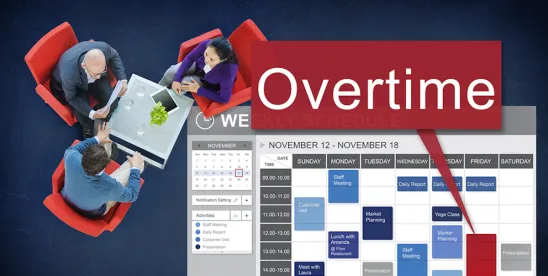Employers are generally required to pay nonexempt employees overtime compensation of at least one and a half times their regular rate of pay for hours worked over 40 in a workweek.
While this is nothing new for employers, determining an employee’s regular rate is often more complex than one might think, and it is often a great cause of confusion for employers.
As we have previously discussed on this blog, the regular rate is a term of art that encompasses all nondiscretionary payments to an employee, and not just hourly wages—subject to certain exceptions. (For a discussion of what must be included in the regular rate, please see our prior post.) If, for instance, an hourly, non-exempt employee receives a productivity bonus, the regular rate for that employee is the hourly rate of pay plus the productivity bonus.
The Department of Labor Fact Sheet #56A explains the basic calculation of the regular rate in the following way:
Total compensation in the workweek (exclusive of statutory exclusions) ÷ Total hours worked in the workweek = Regular rate for the workweek
Seems simple right? Not quite.
The Fair Labor Standards Act (“FLSA”) and certain state laws allow employers to exclude certain types of compensation from the regular rate. Moreover, when a payment is properly excluded from an employee’s regular rate, such payment becomes credible toward any FLSA overtime compensation owed to the employee. In other words, under the FLSA, employers can realize a cost savings by properly excluding payments from regular rate calculations. However, note that several states with their own overtime requirements do not permit such credits.
Many courts have held that employers carry the burden of showing that a statutory exclusion applies—and this is when the confusion typically sets in.
Pursuant to Section 7 of the FLSA, there are eight categories of excludable payments, including, among others, gifts, discretionary bonuses, profit-sharing plans, employer contributions to benefit plans, and stock options. The Department of Labor’s regulations provide further clarity on what types of compensation are excludable from the regular rate of pay. There are also three exclusions for premium pay (or extra payments for certain hours or days of work), including for: (1) hours worked in excess of a daily or weekly standard; (2) hours worked on Saturdays, Sundays, and other special days; and (3) hours worked outside of normal starting and ending times. These premium pay exclusions are particularly complex and worth delving into.
Premium Pay for Hours Worked in Excess of a Daily or Weekly Standard
Section 7(e)(5) of the FLSA allows employers to exclude premium pay hours worked in excess of a daily or weekly standard when the premium is:
- Provided under an employment contract, agreement, understanding, handbook, policy, or practice (formal agreements are not required); and
- For employees who (i) work more than 8 hours in a day or 40 hours in a workweek, or (ii) work more than their normal hours of work for the day or week when their normal or regular daily or weekly hours are more or less than 8 in a day or 40 in a workweek (e.g., 7 in a day or 35 in a workweek).
For example, under the FLSA, an employee who receives an hourly wage of $16 per hour and a contractual overtime rate of $20 per hour for hours worked over 8 in a day or 40 in a workweek, the employer can exclude the $4 premium from the employee’s regular rate and credit the $4 toward the statutory overtime compensation owed. If the employee works 5 hours of overtime and is paid $100 in overtime compensation based on the contractual agreement, then the employee is only owed an additional $20 in overtime compensation.[1]
Premium Pay for Hours Worked on Saturdays, Sundays, and Other Special Days
Similarly, under Section 7(e)(6) of the FLSA, employers may exclude premium pay for hours worked on certain days, such as Saturdays, Sundays, and other special days, like holidays. The premium pay, however, must be:
- For work actually performed on special days, including Saturdays and Sundays, holidays, regular days of rest, and the sixth or seventh day worked in a workweek; and
- Equal to at least one and a half times the bona fide base rate.
While a formal agreement is not required, there must be some form of understanding or agreement between the employer and employee, which, similar to the Section 7(e)(5) exclusion above, can be satisfied by an employment contract, agreement, understanding, handbook, policy, or practice.
Additionally, the bona fide base rate must be “established in good faith,” which generally means that the base rate must yield at least one and a half times the federal minimum wage.[2] If an employee earns an hourly rate above the federal minimum wage, then, to qualify as a bona fide base rate, the base rate must yield at least one and a half times the employee’s hourly rate.
A bona fide base rate would, for instance, be established where an employee with an hourly wage of $20 per hour is paid at least $30 per hour for work on the special days described above. In this example, in one workweek, this employee worked a total of 42 hours, 12 of which were worked over the weekend (on Saturday and Sunday). This means that the employee would earn $960 in total contractual pay, of which $120 is special day premium pay that the employer could credit towards the employee’s weekly overtime. Since the total statutory compensation owed to the employee is $860, no additional overtime compensation is due to the employee because the special day premium pay more than covers the weekly statutory premium pay.[3]
Premium Pay for Hours Worked Outside of Normal Starting or Ending Times
Last, but not least, Section 7(e)(7) of the FLSA allows employers to exclude from the regular rate what is often referred to as “clock pattern premiums.”
Unlike the previous two exclusions, Section 7(e)(7) expressly requires clock pattern premiums be paid under an employment contract or a collective bargaining agreement to qualify for the exclusion. Clock pattern premiums must also be paid:
- For work performed at any time before the starting time or after the ending time of an employee’s normal workday or workweek (e.g., work performed between 6:00 pm and 9:00 am where the employee normally works 9:00 am to 6:00 pm); and
- At a rate of at least one and a half times the bona fide base rate for similar work performed during the employee’s normal workday or workweek.
Like the Section 7(e)(6) exclusion described above, the bona fide base rate must be established in good faith and the premium must be paid for work performed at any time before or after the employee’s normal workday or workweek. This means that employers cannot, by contract, limit when the employee earns premium pay to work performed only between the hours of 6:00 pm to 12:00 am, for example.
To demonstrate the exclusion for clock pattern premiums, here is an example of an employee who earns an hourly rate of $20 per hour and normally works 9:00 am to 6:00 pm Monday through Friday. Assuming an employment contract or collective bargaining agreement exists, the bona fide base rate is satisfied where the employee earns $30 per hour for any hours worked outside of the normal work hours (or 6:00 pm to 9:00 am). If the employee works 42 hours in one workweek with 3 hours worked before 9:00 am on Monday, Tuesday, and Wednesday (for a total of 9 hours before the employee’s normal starting time), then the employee would not be owed any additional overtime compensation because the employee would have received $90 in clock-pattern premium pay which is greater than the $60 owed in statutory overtime premium pay.[4]
ENDNOTES
[1] Calculations Breakdown: (1) Total Contractual Pay: ($16 x 40 hours) + ($20 x 5 hours) = $740; (2) Statutory Overtime Rate: $16 x 1.5 = $24 per hour; (3) Total Statutory Premium Pay Owed: ($16 x 40 hours) + ($24 x 5 hours) = $760; (4) Total Statutory Overtime Compensation Owed with Credited Premium Pay: $760 – $740 = $20
[2] Federal minimum wage is currently $7.25 per hour, and an employee would earn overtime compensation at a rate of approximately $10.88 per hour based on the federal minimum wage.
[3] Calculations Breakdown: (1) Total Contractual Pay: ($20 x 30) + ($30 x 12) = $960; (2) Total Special Day Premium Pay: ($30 – $20) x 12 = $120; (3) Total Statutory Compensation Owed: ($20 x 40) + ($30 x 2) = $860; (4) Total Statutory Overtime Premium Pay Owed: $860 – $960 = –$100
[4] Calculations Breakdown: (1) Total Clock-Pattern Premium Pay: ($30 x 9) – ($20 x 9) = $90; (2) Total Contractual Pay: ($20 x 42) + $90 = $930; (3) Total Statutory Compensation Owed: ($20 x 40) + ($30 x 2) = $860; (5) Total Statutory Overtime Premium Pay Owed: $860 – $930 = –$70




 />i
/>i
